We may not have the course you’re looking for. If you enquire or give us a call on +60 1800812339 and speak to our training experts, we may still be able to help with your training requirements.
Training Outcomes Within Your Budget!
We ensure quality, budget-alignment, and timely delivery by our expert instructors.
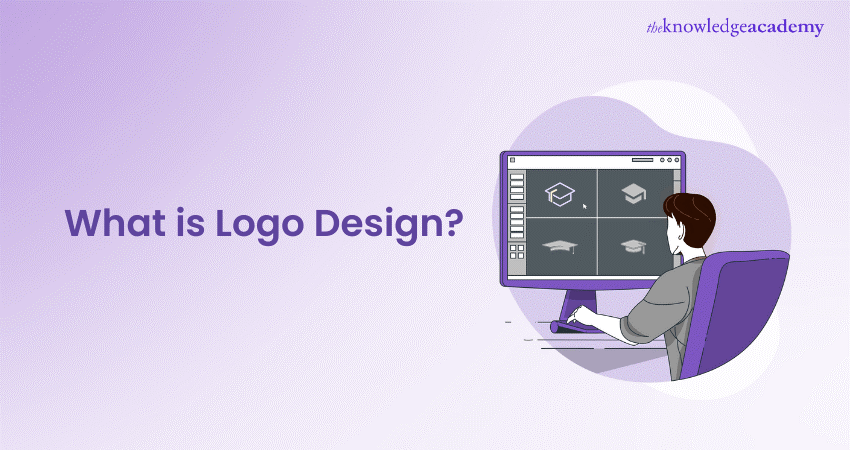
When any business is established, it requires an identity that will help it stand apart from its competitors and impact the market. This identity is created with the help of Logo Design. But What is Logo Design? It is more than just crafting a pleasing image for a business. It is also about capturing a company's essence, values, and aspirations into a symbol that resonates with its audience.
Essential elements like colour psychology, typography, and imagery are examined while creating a brand logo. Several instances must also be taken care of before you make an effective logo design. In this blog, you will learn about What is Logo Design, its characteristics, and factors essential to create the best Logo Design.
Table of Contents
1) What is Logo Design?
2) Types of Logos
3) The role of Logo Design
3) Essential elements of a Logo
4) Characteristics of an effective Logo Design
5) Factors to contemplate when selecting a Logo
6) Conclusion
What is Logo Design?
Logo Design is a creative process that involves developing a unique symbol or graphic representation for a Brand or company. It's a crucial aspect of visual Branding, as the Logo often serves as the first point of contact between a business and its potential customers. An effective Logo is more than a mere graphic.
It conveys the Brand's identity, values, and message in a visually appealing and instantly recognisable manner. This process combines artistic elements like colour, typography, and imagery to create a distinctive and memorable emblem. The goal is to craft an image that encapsulates the essence of the Brand, making it instantly identifiable and leaving a lasting impression on its audience.
Types of Logos
The types of Logos represent various approaches to capturing a Brand's identity visually, each with its unique style and impact.
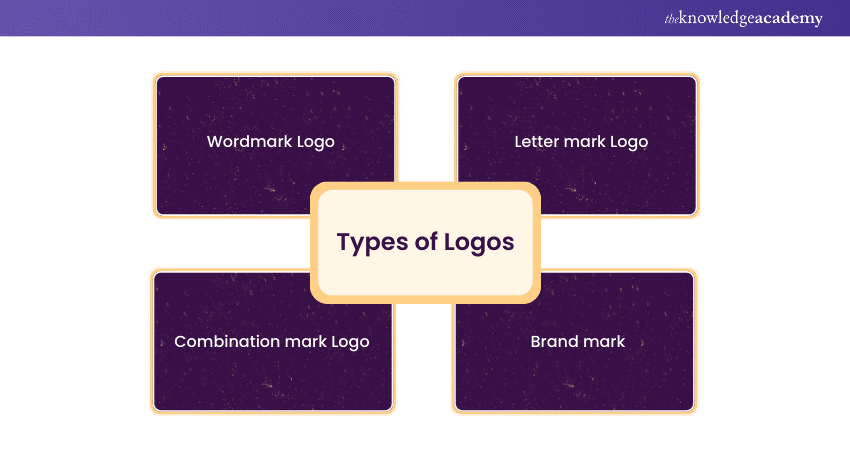
1) Wordmark Logo
This type focuses on the Brand name, presented in a stylised text format. It's ideal for companies with a distinctive name that becomes a memorable Brand identity when presented in a unique font or colour scheme. Examples include Google and Coca-Cola, where the Brand name, through distinctive typography, becomes the Logo itself.
2) Letter mark Logo
Similar to wordmarks, letter marks are typography-based Logos but use initials instead of the full name. This style is excellent for companies with lengthy words, as it simplifies the design and makes it easier to remember. Brands like IBM and HBO effectively use their initials to create a compact, visually appealing representation.
3) Combination mark Logo
These Logos combine a symbol or icon with a wordmark or letter mark. This approach offers the versatility of using either or both elements across various applications. Brands like Adidas and Lacoste use this type to associate a visual icon with their name, enhancing Brand recognition.
4) Brand mark
This type of Logo is also known as a pictorial mark. It uses a symbol or icon without text. The sign must be exceptionally recognisable, as it solely represents the Brand. Apple’s apple and X’s bird are quintessential examples of symbols becoming synonymous with the brand.
Are you interested in learning about Animation? Sign up now for our Animation and Design Training!
The role of Logo Design
Let’s discuss some of the roles of Logo Design:
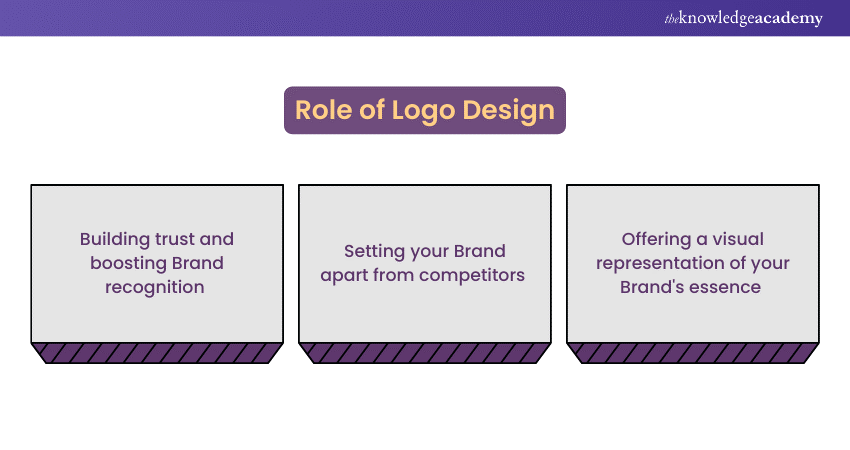
1) Building trust and boosting Brand recognition
The primary role of a Logo is to build trust and foster Brand recognition. In a world where consumers are bombarded with countless Brands, a well-designed Logo helps a company stand out. It acts as a silent ambassador, fostering a sense of familiarity and reliability. For instance, when consumers see the golden arches of McDonald's, it immediately evokes a sense of intimacy and trust, regardless of geographical boundaries. This instant recognition is crucial in building a loyal customer base.
2) Setting your Brand apart from competitors
In competitive markets, a unique Logo can be a company's greatest asset in distinguishing itself from competitors. A Logo tells a company's story in a way that words alone cannot. It captures the company’s personality, making it more than just another entity in the market. For example, Apple Inc.'s bitten apple distinguishes it from other tech companies and communicates simplicity and innovation, setting it apart in a crowded market.
3) Offering a visual representation of your Brand's essence
A Logo is often the first point of interaction for potential customers and thus plays a critical role in making a first impression. It's a visual metaphor that conveys the Brand's underlying message. For instance, the swoosh of Nike represents speed and motion, resonating with the Brand's commitment to fitness and athleticism. This symbolism helps customers identify with the Brand's values and philosophy.
Become an expert in Animation today – Sign up now with our Animation Masterclass!
Essential elements of a Logo
The essential elements of a Logo play a pivotal role in its effectiveness and impact. These elements combine to create a visual representation that is aesthetically pleasing and communicates the essence of the Brand it represents.
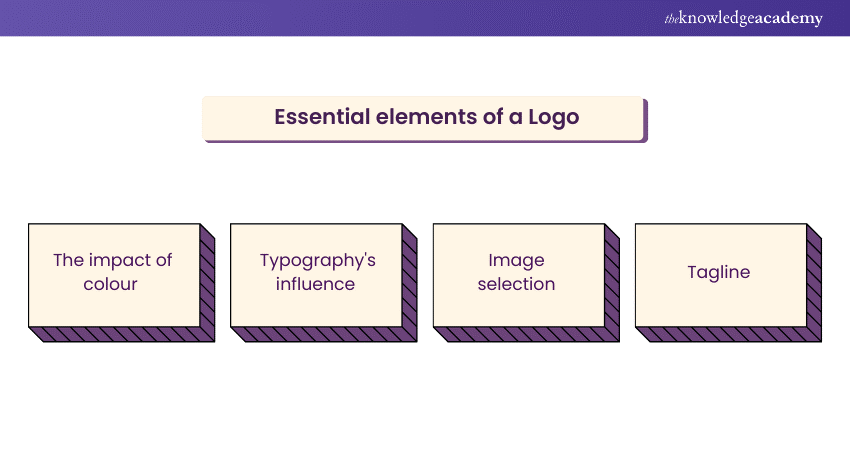
1) The impact of colour
Colour is a powerful tool in Logo Design, carrying psychological connotations that can profoundly affect how a Brand is perceived. Different colours evoke different emotions and associations. For example, blue often conveys trust, stability, and professionalism, making it a popular choice in corporate Logos. Red, on the other hand, can evoke feelings of energy and passion. The right colour choice can enhance a Logo's effectiveness by aligning with the Brand’s personality and values and making it stand out in the consumer's mind.
2) Typography's influence
The choice of typeface in a Logo Design significantly affects its overall impact. Typography can convey the personality of the Brand – whether it’s traditional, modern, whimsical, or profound. Serif fonts, for instance, are often seen as classic and trustworthy, while sans-serif fonts can appear more modern and cleaner. The legibility of the typeface is also crucial, especially for wordmark Logos, as it ensures the Brand name is easily recognisable.
3) Image selection
The imagery or icons used in a Logo must be carefully considered. Images should be relevant to the Brand, easy to interpret, and memorable. They can range from literal representations, like a tree for an environmental organisation, to more abstract symbols. The key is to choose an image that complements and reinforces the Brand message and identity.
4) Tagline
While not necessary, a tagline can be a valuable addition to a Logo. It offers a quick, concise way to communicate the Brand’s mission, values, or essential benefits. A tagline should be short, catchy, and directly tied to the Brand’s core message. A well-designed Logo seamlessly integrates these elements to create a cohesive and compelling visual identity. It must balance uniqueness and clarity, ensuring that it captures attention and communicates the right message about the Brand.
Do you want to learn how to create the perfect Logo Design? Register now for our Logo Design Training!
Characteristics of an effective Logo Design
An effective Logo Design is more than just a catchy image; it's a critical component of a Brand's identity. Key characteristics define the effectiveness of a Logo in communicating a Brand’s essence and ensuring its recognition and recall.
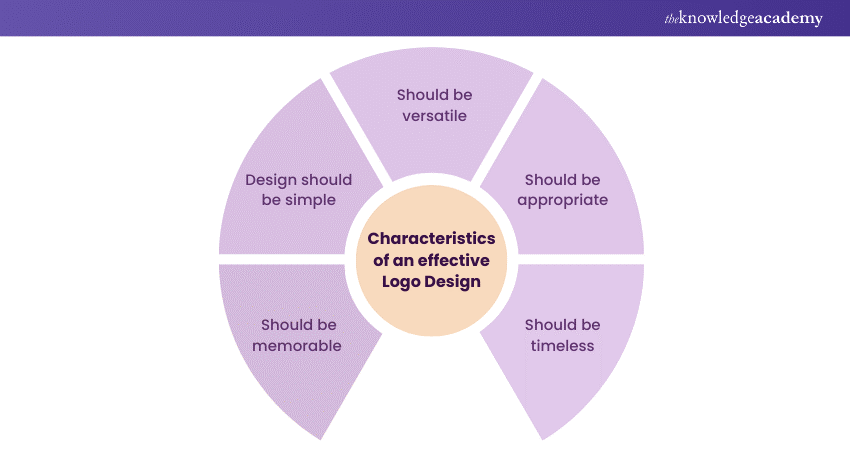
1) Memorable
A great Logo should stick in the viewer's mind. This memorability ensures that the Brand remains at the forefront of its audience's thoughts. For example, the Apple Logo is instantly recognisable and hard to forget, making it highly effective.
2) Simplicity in design
The most impactful Logos are often the simplest. A clean, uncluttered design makes a Logo easily recognisable and more versatile for various mediums. Google's Logo, for instance, is a study of simplistic effectiveness.
3) Versatility in application
An effective Logo must work well in different contexts, sizes, and platforms. It should be as effective on a small mobile screen as on a large billboard. Versatility also means the Logo should be effective in both colour and black and white.
4) Appropriate representation
The design should be appropriate for the Brand’s industry and target audience. For example, a law firm and a children's toy store would have vastly different Logo Designs that are appropriate for their respective fields.
5) Timeless appeal
While trends in design can inspire, an effective Logo should have a timeless quality that doesn't appear outdated as styles change. The Coca-Cola Logo is a prime example of a design that has stood the test of time.
Learn all the essential Sketchbook skills – Join our Sketchbook Essential Training!
Factors to contemplate when selecting a Logo
When choosing a Logo, consider these crucial factors:
a) Brand identity: Ensure the Logo aligns with your Brand’s values, mission, and personality.
b) Target audience: Tailor the Logo to appeal to your specific audience demographic.
c) Uniqueness: Choose a design that stands out from competitors and avoids cliches.
d) Scalability: Ensure the Logo is legible and effective at various sizes and applications.
e) Colour scheme: Select colours that convey the desired emotions and Brand message.
f) Typography: The font should complement the Brand's character if the text is included.
g) Cultural sensitivity: Be aware of cultural implications and interpretations of the design.
h) Futureproofing: Opt for a design that won’t quickly become outdated.
i) Versatility: The Logo should work across different mediums, both digital and print.
j) Legal check: Ensure the design doesn’t infringe on existing trademarks.
Acquire in-depth knowledge about graphics in motion with our Motion Graphics Masterclass!
Conclusion
A Logo is more than just a piece of graphic art; it is also the visual representation of a Brand's identity. Understanding What is Logo Design will help you capture a Brand's essence, make it stand out, and communicate its message to the audience. Understanding the various types of Logos, their roles, essential elements, and the characteristics that make up effective designs is crucial in creating a Logo that looks good and fulfils its purpose in Branding and marketing.
Acquire in-depth knowledge about graphics in motion with our Motion Graphics Masterclass!







 Top Rated Course
Top Rated Course




 If you wish to make any changes to your course, please
If you wish to make any changes to your course, please


